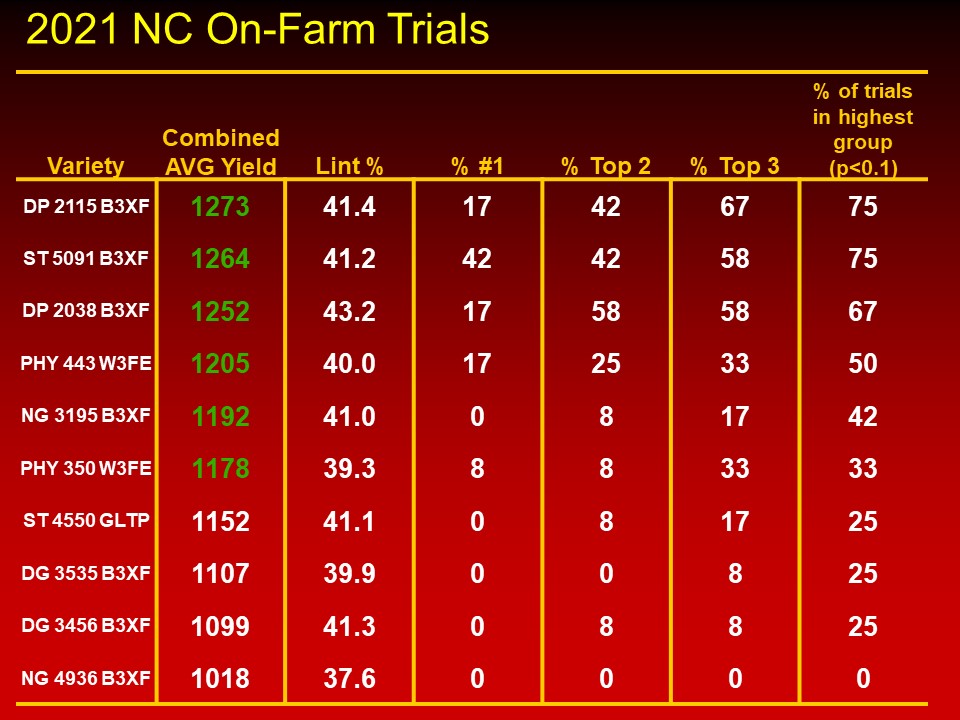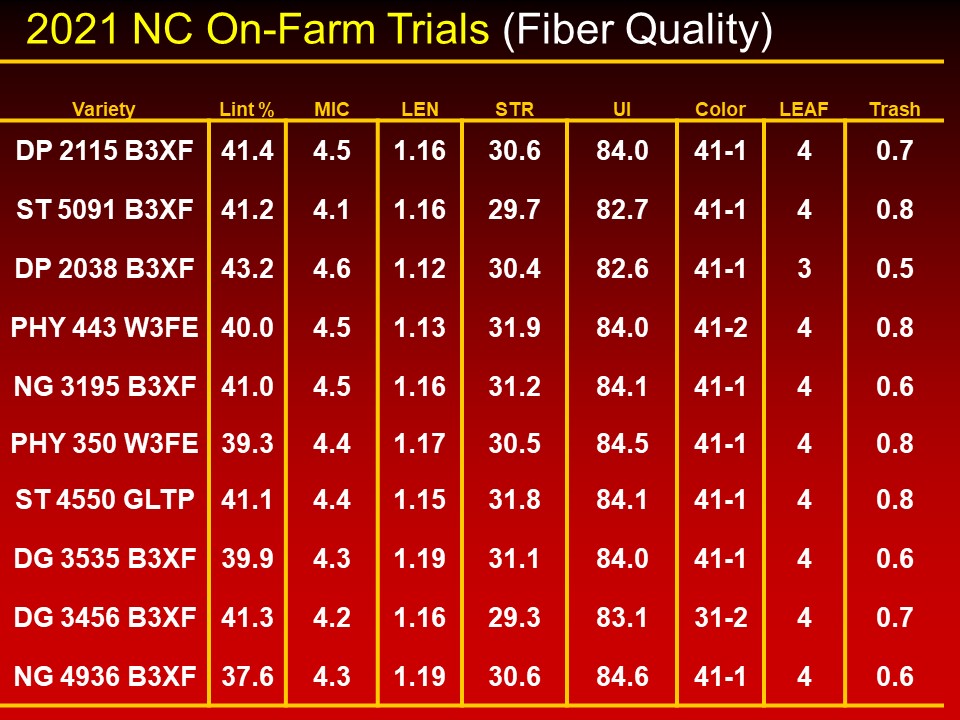Yield & Quality Results for the 2021 NC On-Farm Cotton Variety Evaluation Program (Collins & Edmisten)
go.ncsu.edu/readext?838117
en Español / em Português
El inglés es el idioma de control de esta página. En la medida en que haya algún conflicto entre la traducción al inglés y la traducción, el inglés prevalece.
Al hacer clic en el enlace de traducción se activa un servicio de traducción gratuito para convertir la página al español. Al igual que con cualquier traducción por Internet, la conversión no es sensible al contexto y puede que no traduzca el texto en su significado original. NC State Extension no garantiza la exactitud del texto traducido. Por favor, tenga en cuenta que algunas aplicaciones y/o servicios pueden no funcionar como se espera cuando se traducen.
Português
Inglês é o idioma de controle desta página. Na medida que haja algum conflito entre o texto original em Inglês e a tradução, o Inglês prevalece.
Ao clicar no link de tradução, um serviço gratuito de tradução será ativado para converter a página para o Português. Como em qualquer tradução pela internet, a conversão não é sensivel ao contexto e pode não ocorrer a tradução para o significado orginal. O serviço de Extensão da Carolina do Norte (NC State Extension) não garante a exatidão do texto traduzido. Por favor, observe que algumas funções ou serviços podem não funcionar como esperado após a tradução.
English
English is the controlling language of this page. To the extent there is any conflict between the English text and the translation, English controls.
Clicking on the translation link activates a free translation service to convert the page to Spanish. As with any Internet translation, the conversion is not context-sensitive and may not translate the text to its original meaning. NC State Extension does not guarantee the accuracy of the translated text. Please note that some applications and/or services may not function as expected when translated.
Collapse ▲For many or most growers across North Carolina, 2021 will be a year to remember for quite a while. It is very rare that high prices, timely rains throughout the summer, avoidance of tropical storms or prolonged cloudy/wet weather during September/October, good harvest weather, and high yields (in many areas) all align within a single year, but they did for many growers in 2021. It seemed that most of our challenges were experienced during planting season, with intermittent cool weather, and even dry conditions, that prolonged our planting season and resulting in a portion of our crop maturing later than normal. All is well that ends well. Yields were variable, as they always are, and some areas experienced some degree of drought stress during August. However, there are many areas reporting 3-4 bale dryland yields, and many growers have either stated that this was their best year ever, or second best. In the large majority of cases, economically speaking, many have reported that this was their best year ever.
Thanks to our stellar cooperating growers and county agents, we were able to successfully complete another year of the North Carolina On-Farm Cotton Variety Evaluation Program. Additionally, this program was once again a success in 2021, thanks to the substantial support from the NC Cotton Producers Association, N.C. Department of Agriculture and Consumer Services, NC State University, our Seed Companies, and Cotton Incorporated. The support and contributions of all involved are much appreciated, and will have significant impact on our growers’ bottom line as we look forward to a hopefully another prosperous 2022 season.
As in years past, this on-farm program consists of the most widely-adapted and best-fit varieties for North Carolina cotton growers as determined by our leading seed companies. It is always advised that variety decisions be based on multi-environment and multi-year replicated data in order to identify varieties with a high degree of stability (strong performance across a wide range of environmental conditions and years). As a standard practice, it is always wise for growers to choose several varieties and position those varieties in environments where they are likely to perform competitively. It is also advised that growers observe data from both the on-farm program and NC State University Official Variety Trials (OVT) which will be available very soon. Both programs serve as platforms for effective evaluation of variety performance but are different in several regards. One of the primary strengths of the on-farm program is the vast number of environments that are effectively captured in a given season. However, OVT can accommodate many more varieties than we can effectively evaluate in an on-farm trial, and many of our seed companies have several competitive varieties (including brand new, recently released varieties) available for North Carolina producers, many of which are evaluated in OVT. Together, the On-Farm and OVT programs collectively offer growers a complete platform for making variety decisions.
Within the 7th year of this program (which is hard to believe) alone, the on-farm program again has clearly demonstrated that variety selection is one of the most important decisions a grower can make that will significantly impact their profitability in a given year. Depending on the degree of variety selection error, the 2021 on-farm trials clearly illustrated that producers could lose an average of $153 to $331 per acre due to improper variety selection, with a potential statewide economic value of $53,550.000 to $115,850,000!! Keep in mind, that these figures are based on performance of the best varieties from each brand, therefore a producer could do much worse than this by potentially choosing a less competitive variety.
Variety performance information will be discussed in much greater detail during the upcoming winter meetings (look for meeting dates/locations for your county at your local N.C. Cooperative Extension office or on the NC State University Cotton Portal (meeting dates are now listed). Additionally, your local county agent is an excellent resource for variety selection, so please contact them for your local trial results and they will be happy to share those results with you. Additionally, the NC Cotton Variety Performance Calculator, launched in early 2016, is an excellent resource for growers to use to make customized variety comparisons based on geographical region, yield environment, years or multi-years, and trial type. The calculator is now updated with lint yields and fiber quality of the 2021 On-Farm trials. The calculator will be updated with OVT data as soon as those results are in from the statistician.
The slide below offers a very general summary of variety performance across the state. Variety performance data will be dissected in much greater detail during the upcoming winter meetings. This year, as always, growers should focus more on factors such as stability characteristics, versus focusing on the overall variety ranking of single-year data alone. There are several ways to approach and observe 2021 variety performance data, and this will be explained thoroughly during meeting season. Therefore, growers might want to hold off on making any definite variety decisions until these various approaches can be discussed thoroughly during winter meetings. However, the slide below can be used as a very general summary for now.
In this slide, varieties are ranked in descending order according to average yield across all trials in the analysis. Varieties with yields highlighted in green indicate that yields were above average across all locations. The percentage of trials in which a variety performed at the top, within the top 2, within the top 3, and most importantly, within the statistically highest yielding group are also shown. As mentioned earlier, individual trial results can be obtained from your local county agent and in the variety calculator. Results for OVT and fiber quality will be available soon. Again, growers are also encouraged however to observe multi-location and multi-year data before making variety decisions. Due to the clear variation in performance between trials and years, it is not wise to base variety decisions on results from a single trial or even a small number of trials.
In addition to yield, fiber quality is an important component to the value and marketability of cotton in our state and should be considered when selecting varieties. The table in the link below illustrates the average fiber quality values for each variety across all on-farm trials in 2021. Parameters include lint percentage, micronaire (MIC), fiber length (LEN), fiber strength (STR), length uniformity (UI), color grade, leaf grade, and trash.
As you can see, fiber quality for nearly all varieties in this program were good to excellent. There was only one incidence of high micronaire with one variety in one trial, no cases of discount short staple, and fiber strength, uniformity, color grades. leaf and trash grades were either excellent or at acceptable/normal levels. These results are a true testament to NC cotton producers, as well as all of our seed companies and ginners, all of whom are dedicated to producing high-quality cotton and remaining competitive in the global marketplace. Several growers have also reported a high number of premium grades from their crop this year. This is definitely something to be celebrated.
Again, results from the on-farm program along with OVT will be discussed in much greater detail during the upcoming winter meetings, so be sure to attend one near you. Also, we want to again reiterate our appreciation to all of our leadership organizations (NC Cotton Producers Association, NCDA&CS, NC State, Cotton Inc.) and Seed Companies for their efforts and support in this program for the benefit of all North Carolina cotton growers, as well the diligence and hard work that our county agents, consultants, and cooperating growers put into this program during 2021. This program was a success again in 2021 due to the efforts of all involved and we look forward to another year of this program in 2022!




